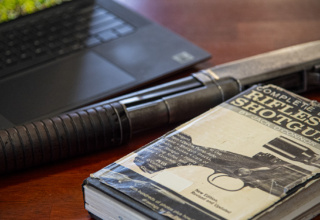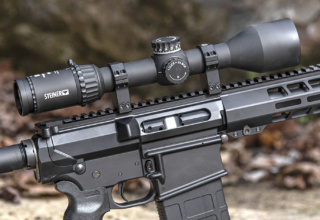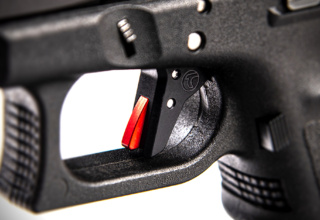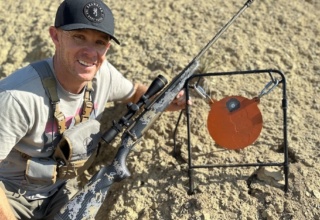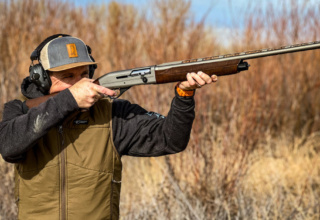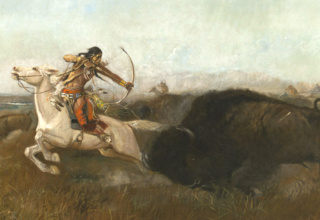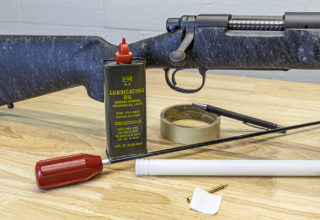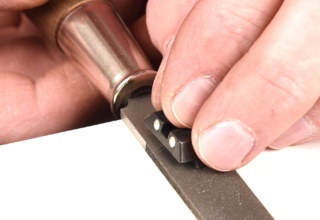Need to fill the freezer but ammo is tight? Traditions Firearms and Federal Premium have teamed up to shorten the learning curve for new muzzleloader hunters.
by Rob Reaser; photos by Rob Reaser and Matt Church
Let’s just lay the cards right on the table—hunting with a muzzleloader can be intimidating for first-timers. Many folks are a tad nervous about handling black powder. Still others are squeamish over the many steps involved and the perceived “high maintenance” associated with front-stuffers.
The truth is, while muzzleloaders may seem like “too much bother” for the uninitiated, veteran blackpowder shooters and hunters will be quick to knock down those common concerns and extol the many virtues of picking up a firearm that hearkens back to our pioneering ancestors. Of course, the modern inline muzzleloader bears only a functional resemblance to those smokepoles of yore. Today’s guns are easier to use and most are based on a platform that is quite familiar to anyone who regularly shoots cartridge rifles.
Earlier this year, the folks at Traditions Firearms, Federal Premium, and Hodgdon wrote the next chapter in the rich muzzleloader story with the introduction of the Traditions NitroFire rifle and the groundbreaking technology that made it happen…the Federal Premium FireStick.
The short story is this: the revolutionary FireStick and the NitroFire have effectively addressed the concerns or issues that have kept many hunters from getting into muzzleloaders. By making muzzleloaders easier to load, easier to clean, safer to operate, and more accurate and reliable under all conditions, Traditions and Federal have removed the learning curve and the psychological barriers typically associated with using muzzleloaders.
Shoot On contributor Brad Fenson provided a detailed review of the NitroFire/FireStick system a couple months ago. Since then, we’ve had a chance to put the system to the test in real-world hunting conditions on a recent deer hunt in the famed Sandhills region of northern Nebraska. Not only did the NitroFire live up to its burgeoning reputation as a reliable, safe, and accurate muzzleloader system, it certified its credentials by dropping three mulies and a whitetail on our hunt in the open country, where long stalks and heavy winds made for challenging hunting conditions.
My take on the NitroFire began east of the Mississippi, where I spent time getting familiar with this new way of making .50 caliber bullets go downrange with precise authority.
To begin, the NitroFire is the only muzzleloader currently on the market that is designed to work with Federal Premium’s new FireStick technology. What is the FireStick? It is a polymer capsule containing either a 100- or 120-grain equivalent of Hodgdon’s new Triple 8 powder. The capsule is sealed, making the contained powder impervious to moisture intrusion. That’s a big advantage over traditional loose or pelletized powder. At the base of the capsule is a pocket that accepts standard 209 shotgun primers, which are used for the ignition source just like conventional inline muzzleloaders.
So, how does it work?
The FireStick is simply a capsule with powder and a primer pocket. The NitroFire, unlike conventional inline muzzleloaders, does not have breech plug. Rather, the breech is open to accept the FireStick. Just seat a bullet down the barrel, break open the rifle, and insert the FireStick. Place a 209 shotgun primer into the FireStick primer pocket, close the breech, and the rifle is loaded and ready to shoot.
Benefits of the NitroFire were revealed as soon as I hit the range to figure out the optimal load for my barrel and to zero the scope. For starters, everything is much less complicated thanks to the reduced supplies needed. With the FireStick system, there is no need to add cans of powder, funnels, powder chargers, or any of the other standard accouterments typically found on the muzzleloader bench. All you need are the FireStick charges (100- or 120-grain), bullets of your choice, and a box of primers.
Another plus I noticed is that the new Hodgdon Triple 8 powder in the FireSticks seems to burn cleaner and leave less fouling in the barrel than conventional powders. This is a very subjective observation, mind you, but I was able to easily seat multiple (as many as 10) Traditions Carnivore sabot bullets and Federal Premium’s Trophy Copper B.O.R. Lock MZ bullets between bore cleanings. Further, accuracy did not suffer between those cleaning sessions. That’s not a big deal during the hunt, but it’s a major help when zeroing.
A HUGE benefit on the range and especially in the field is accuracy. While carefully measured loose powder combined with consistent bullet seating can deliver exceptional accuracy in a muzzleloader, loading in the field can introduce variables that may lead to shifting points-of-impact. Pelletized powder has removed some of those loading variables but not all (such as accidental crushing of the pellets). With the NitroFire and FireStick system, those variables are largely removed. Bullet seating depth and pressure is easily repeated because you simply push the bullet down the barrel until it stops on the small ledge in front of the “chamber.” The powder charge is, of course, consistent because it is measured at the factory using the same quality control Federal Premium applies to all its products.
As with any firearm, though, load testing is essential to achieve maximum accuracy. Before our hunt in the Nebraska Sandhills with Goose Creek Outfitters, I tested assorted Traditions Smackdown bullets and Federal’s Trophy Copper B.O.R. Lock MZ bullets along with the 100- and 120-grain FireSticks. My best results (1.5 MOA) came with the 100-grain FireStick and 270-grain B.O.R Lock MZ bullet combination, although the Carnivores in 175-grain ran a close second. Another thing I liked about the B.O.R Lock MZs is their ease of loading. The non-sabot design requires significantly less pressure to push down the barrel than conventional sabot bullets while the expandable polymer base cup ensures a proper gas seal for maximum efficiency. Yet again, it all depends on what your rifle likes the best.
Sadly, my first official field outing with the NitroFire was short-lived. I was after mule deer and asked guide Matt Church for a spot-and-stalk hunt to kick off the opening day of Nebraska’s rifle season. Matt said, “I know just where to go.”
After an hour’s drive through what seemed to be some of the most remote country in the Lower 48, we parked the truck and struck off into the undulating Sandhills just after legal shooting light. We were into deer almost as soon as we stepped out of the truck. A couple whitetail does and a small 6-point (3-point, as weighed in this neck of the country) were angling along a hill above us. Not what we were looking for, but certainly enough excitement to get the adrenaline going.
For the next three hours we slipped our way up and down the grassy dunes, peaking into cozy ravines and glassing across the hills in search of a rutting mulie. The sandy folds of earth held only a few whitetails this morning, but Matt and I enjoyed watching a herd of pronghorns milling in a broad valley to the north of the hills we were pounding.
With the mulies making themselves scarce, Matt sketched out a plan.
“Let’s angle along the side of this hill and around that high point,” he offered. “We can glass down the other side and see if there’s anything over that way.”
“Sounds like a plan,” I replied. I learned some time ago that a successful hunt, 9 times out of 10, requires following your guide’s advice to the letter. They know what they’re doing!
We probably had not walked 100 yards before Matt whispered, “Deer!” I dropped to my knees to keep beneath the rise in front of us and looked over at Matt. He was glassing straight ahead against the side of the hill.
“He’s coming right at us,” Matt explained.
It turned out to be a mulie buck—a healthy 4×4 that I knew immediately was a taker. Not a monster, but a good-sized body that would fill a lot of freezer space. As a friend of mine likes to say, “Never pass up a deer on the first day of the hunt that you would take on your last day.”
Sound advice.
Seems our intended spot-and-stalk quite turned into a spot-and-drop.
I suggested to Matt a short belly-crawl up the rise in front of us so I could get in a good prone position for the shot. Sliding through the short grass and snagging evil sand spurs in our clothes, we got to a spot that kept us hidden while we waited for the buck to show his vitals.
The deer wasn’t in a big hurry. In fact, he seemed more irritated than anything. For five or ten minutes we watched him work along the hillside, weaving through the brush and smacking any small tree that dared get in his way. Yep, this boy was in a rank mood, and we were soon to find out why.
Matt first spotted the buck at 225 yards and called the distance as the mulie continued closer to us. By the time he had closed the gap to around 75 yards, I was getting a bit nervous. Another 30 yards and he was going to disappear in the dip below us. Fortunately, he slowed and turned slightly uphill. I settled for a slightly quartering-to shot, placing the crosshairs just forward of his shoulder line to save meat yet ensure a good shot angle through the vitals.
I pulled back the NitroFire’s hammer and flipped off the safety before settling the crosshairs and sendgin the 270-grain Trophy Copper B.O.R. Lock downrange.
Immediately after the BOOM, Matt was up on his knees and let loose, “He’s coming right at us!”
There was nothing in my view but tawny grass. The buck had dropped below my line of sight. Grabbing my ramrod to reload, I was half expecting the deer to run me over until Matt said, “He’s going down.” I looked up and saw the buck giving its final kicks a mere 35 yards away.
He was a beautiful mulie and my first Nebraska buck. He made us work for it, and I had the pleasure of watching him come in from 225 yards out. Having that extended time with an animal before harvesting it is important to me. It rounds out the story and strengthens my emotional connection to nature and to the animals we take to feed ourselves.
Oh…and we figured out why this buck had been cruising the slopes that morning with such a foul disposition. His left ear was neatly sliced—still raw and bloody. Sometime during the previous night, he had a tangle with a buck that had just a bit more mettle than he did. Perhaps if you arrange a hunt with Goose Creek Outfitters next year, you may get a chance at THAT bruiser!













